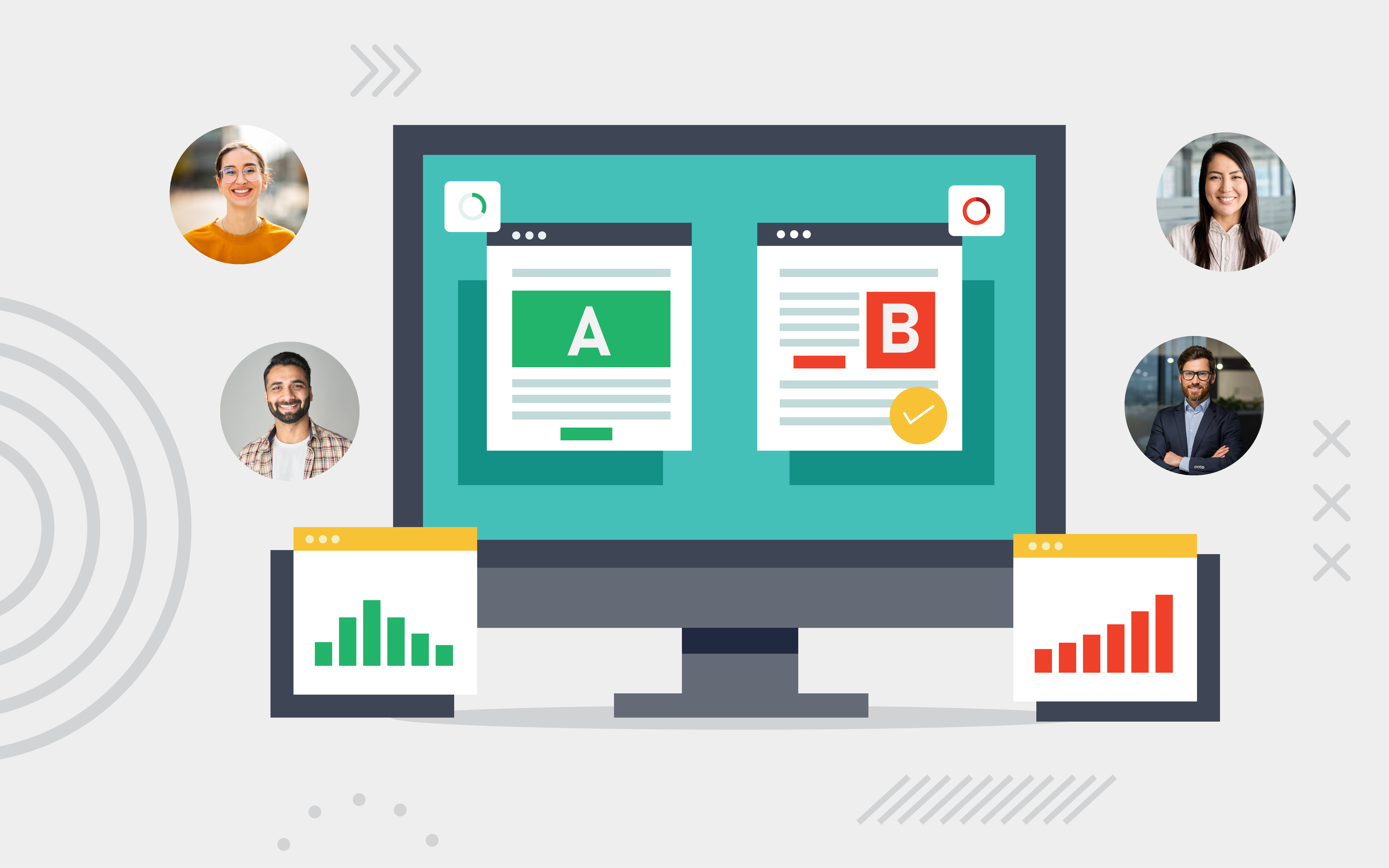Dive into our comprehensive guide to discover how this powerful tool can revolutionize your marketing strategy and boost your success.
Contents
What is A/B Testing?
A/B testing, also called split testing, is a way to compare two versions of something to see which one works better. Imagine you have two different headlines for a webpage, and you want to know which one gets more people to click. You show one headline to half your audience (version A) and the other headline to the other half (version B). Then you compare the results to see which headline gets more clicks.
Key Elements of A/B Testing
A/B testing involves several key elements that ensure the process is effective and the results are reliable.
- Control and Variation: The control is the original version (A), and the variation is the new version (B) that you want to test against the control. By comparing these two, you can see if the changes you made had a positive effect.
- Metrics and KPIs (Key Performance Indicators): These are the numbers you look at to see if the test worked. Common metrics include click-through rates (how many people clicked on something), conversion rates (how many people completed a desired action), and bounce rates (how many people left your site quickly). These metrics tell you if the changes you made are improving your results.
A/B testing is like a marketing science experiment. By following these steps, you can find out what works best for your audience and improve your marketing efforts based on real data.
Why A/B Testing is Important in Marketing
An A/B test is the perfect way to measure engagement, experience, and overall website performance–especially in B2B marketing.
Enhancing User Experience
A/B testing is crucial for enhancing user experience. By testing different versions of a webpage or an app, you can determine which version your audience prefers. Improving website design and functionality through A/B testing helps make your site more user-friendly and engaging.
Personalizing content for different audience segments ensures that each visitor gets a tailored experience that meets their needs and preferences.
Increasing Conversion Rates
One primary goal of A/B testing is to increase conversion rates. By optimizing landing pages, headlines, call-to-action buttons, and other elements, you can significantly boost the number of visitors who take the desired action, such as signing up for a newsletter or making a purchase.
Numerous case studies showcase successful A/B tests where small changes led to substantial improvements in conversion rates. For example, changing the color of a button or the wording of a headline can have a dramatic impact on user behavior.
Reducing Bounce Rates
A high bounce rate indicates that visitors are leaving your site quickly without interacting with it. A/B testing can help identify and fix issues that lead to high bounce rates. By testing different content layouts, load times, and navigation structures, you can find out what keeps users engaged and encourages them to stay longer on your site.
Examples of effective solutions through A/B testing include simplifying navigation menus, improving page load speed, and making content more accessible and relevant.
How A/B Testing Works
A/B testing follows a simple step-by-step process to help you figure out what works best in your marketing efforts. By carefully setting up and running these tests, you can make data-driven decisions that improve your results.
- Identify Your Goal: First, decide what you want to achieve. This could be getting more people to click a button, sign up for a newsletter, or buy a product. Having a clear goal helps you know what to measure.
- Create Variants: Make two versions of the thing you want to test. For example, if you’re testing a webpage, create two different headlines or images. Version A is the original (control), and version B is the new version (variation).
- Divide Your Audience: Show version A to one-half of your audience and version B to the other half. This division should be random to ensure fair results. Randomly splitting your audience ensures that the test results are not biased.
- Run the Test: Let the test run for a set period. Make sure you have enough data to get reliable results. The length of time can vary depending on how much traffic your site gets. More traffic means you can get results faster.
- Measure the Results: Compare how each version performed based on your goal. Look at the metrics like click-through rates, conversion rates, or any other important measurements. These metrics help you understand which version is more effective.
- Analyze and Decide: See which version did better. Use this information to make decisions and improve your marketing strategy. If version B performs better, you might want to use it as your new standard.
Key Elements of A/B Testing
A/B testing involves several key elements that ensure the process is effective and the results are reliable.
- Control and Variation: The control is the original version (A), and the variation is the new version (B) that you want to test against the control. By comparing these two, you can see if the changes you made had a positive effect.
- Metrics and KPIs (Key Performance Indicators): These are the numbers you look at to see if the test worked. Common metrics include click-through rates (how many people clicked on something), conversion rates (how many people completed a desired action), and bounce rates (how many people left your site quickly). These metrics tell you if the changes you made are improving your results.
A/B testing is like a marketing science experiment. By following these steps, you can find out what works best for your audience and improve your marketing efforts based on real data.
What Elements Can You A/B Test?
A/B testing can be applied to various elements of your marketing materials to optimize performance and enhance user experience. Here are some key elements you can test:
- Headlines and Titles: Test different headlines to determine which one grabs attention and encourages users to read further.
- Call-to-Action (CTA) Buttons: Experiment with text, color, and placement of CTA buttons to find the combination that drives the most engagement.
- Page Layout and Design: Adjust layouts to see which one enhances user experience, focusing on navigation, content arrangement, and whitespace.
- Forms: Test variations in form length, required fields, and design to optimize user completion rates.
- Email Subject Lines: Experiment with tone, length, and personalization in subject lines to improve email open rates.
Different Types of A/B Testing
There are different ways to accomplish testing your hypotheses, including:
Split URL Testing
Split URL testing, also known as redirect testing, is a type of A/B testing where two different URLs are tested against each other. In split URL testing, visitors are randomly directed to one of the two URLs. This type of testing is ideal for major changes, like redesigning a webpage or testing different landing pages.
- Advantages and Limitations: Split URL testing allows you to make significant changes and see their impact. However, it can be more complex to set up because it involves creating and managing two separate pages.
Multivariate Testing
Multivariate testing is a more advanced form of A/B testing that involves testing multiple variables at the same time. Instead of comparing two versions, you compare multiple combinations to see which one performs best. In multivariate testing, you test multiple elements (like headlines, images, and buttons) simultaneously to understand how different combinations affect user behavior. This is useful for optimizing a webpage where multiple elements can be improved.
- Advantages and Limitations: Multivariate testing provides detailed insights into how different elements interact. However, it requires more traffic to achieve statistical significance and can be more complex to analyze.
Multipage Testing
Multipage testing involves testing changes across several pages in a user’s journey. This type of testing is useful for understanding how changes on one page impact the overall user experience and conversion rates on a series of pages. In multipage testing, you make changes to multiple pages and test how these changes impact the overall flow and user behavior. This is ideal for testing funnels or checkout processes.
- Advantages and Limitations: Multipage testing helps optimize the entire user journey rather than just a single page. However, it can be more complicated to track and analyze because it involves multiple steps and pages.
By understanding and using these different types of A/B testing, you can make more informed decisions about what changes to implement on your website or in your marketing campaigns. Each type of testing offers unique insights and can help you optimize different aspects of your user experience.
Is your website performing the way you want it to? Abstrakt Marketing Group has the inbound SDR services you need to start optimizing your online presence and generating the leads you have been waiting for.
How to Get Started with A/B Testing
While you may need to do a little research, A/B testing is generally a simple, straightforward process.
Planning Your A/B Test
Before you start an A/B test, proper planning is essential. Begin by identifying your goals and key metrics. What do you want to achieve with your test? Whether it’s increasing click-through rates, improving conversion rates, or reducing bounce rates, having clear objectives helps you measure success accurately.
Next, choose the right tools and platforms for conducting your test. There are many A/B testing tools available, such as Google Optimize, Optimizely, and VWO, which can help you set up and manage your tests effectively.
Executing the Test
Setting up the test environment is a crucial step in executing an A/B test. Ensure that your website or application is ready to display both the control (A) and variation (B) versions to different segments of your audience. Make sure the division of traffic is random to avoid bias in the results.
Once the test is set up, run it for a sufficient period to gather enough data. The duration of the test depends on your website traffic and the magnitude of changes being tested. Generally, the more significant the change, the longer the test should run to ensure accurate results.
Analyzing Results and Implementing Changes
After running your A/B test, it’s time to analyze the results and make data-driven decisions. Look at the metrics you defined earlier to determine which version performed better. Use statistical analysis to ensure that the results are significant and not due to random chance.
Once you’ve identified the winning version, implement the changes on your website or application. Document the results and lessons from each test to inform future A/B testing efforts.
Best Practices for Effective A/B Testing
Following best practices will help you achieve reliable results for your tests, and give you confidence in your results.
Developing a Clear Hypothesis
A successful A/B test starts with a clear hypothesis. Formulating testable and measurable hypotheses is essential for guiding your testing process. Your hypothesis should be specific and based on data or insights about your audience’s behavior. For example, “Changing the call-to-action button color from blue to green will increase the click-through rate by 10%.” Prioritize tests based on their potential impact and feasibility. Focus on changes that are likely to significantly change your goals.
Ensuring Statistical Significance
To make reliable decisions based on your A/B test, it’s important to ensure statistical significance. This means that the results you observe are not due to random chance but reflect a true difference between the control and variation. Understanding sample size and confidence levels is key to achieving statistical significance. Use tools like A/B test calculators to determine the appropriate sample size for your test. Avoid common pitfalls like ending the test too early or not accounting for external factors that could affect the results.
Continuous Testing and Iteration
A/B testing should be an ongoing process rather than a one-time effort. The importance of continuous testing and optimization cannot be overstated. Markets and user behaviors are always changing, so what works today might not work tomorrow. Regularly test new ideas and improvements to keep your marketing strategies effective. Examples of iterative testing for continuous improvement include testing different headlines for the same content over time, experimenting with new design elements, or adjusting targeting criteria for ads.
Mistakes to Avoid with A/B Testing and How to Avoid Them
A/B testing can be a powerful tool for optimizing your marketing efforts, but it’s important to avoid common mistakes that can lead to misleading results. Here are some frequent pitfalls and tips on how to steer clear of them:
Running Tests Without a Clear Hypothesis
Conducting A/B tests without a specific, testable hypothesis can lead to unfocused experiments and ambiguous results. This means you might be testing random elements without a clear idea of what you are trying to achieve, making it difficult to interpret the results.
How to Avoid: Always start with a clear hypothesis based on data or insights. For example, instead of testing random changes, hypothesize that “Changing the call-to-action button color from blue to green will increase the click-through rate by 10%.”
Stopping the Test Too Early
Ending the test before it has run for a sufficient amount of time can result in inaccurate conclusions due to insufficient data. This often happens when you see early positive results and decide to end the test prematurely, which can lead to false positives.
How to Avoid: Use statistical tools to calculate the required sample size and test duration. Allow the test to run until you reach statistical significance, ensuring that the results are reliable and not due to random chance.
Ignoring Statistical Significance
Making decisions based on test results that are not statistically significant can lead to false assumptions and ineffective changes. This means you might implement changes that don’t actually improve performance, based on flawed data interpretation.
How to Avoid: Understand the concepts of statistical significance and confidence levels. Use tools like A/B test calculators to determine if your results are statistically significant before making any decisions.
Testing Multiple Changes at Once
Testing several variables at the same time can make it difficult to determine which change caused the observed effect. This can lead to confusion and incorrect conclusions about what works and what doesn’t.
How to Avoid: Focus on testing one change at a time (unless you’re doing multivariate testing). This approach ensures that you can attribute any differences in performance to the specific change you made.
Not Segmenting Your Audience
Failing to segment your audience can result in skewed data, as different segments may respond differently to changes. This can lead to generalized results that don’t accurately reflect the behavior of different user groups.
How to Avoid: Segment your audience based on relevant criteria such as demographics, behavior, or source of traffic. Analyzing how different segments respond can provide deeper insights and more accurate results.
Overlooking the Impact of External Factors
Ignoring external factors such as seasonality, marketing campaigns, or market trends can lead to misleading conclusions. These factors can significantly influence user behavior and skew test results.
How to Avoid: Consider external factors when planning and analyzing your tests. Run tests long enough to account for these variables, and try to isolate your test from other significant changes in your marketing activities.
Focusing Solely on Short-Term Metrics
Concentrating only on immediate metrics like click-through rates can lead to suboptimal decisions that don’t consider long-term impacts. This short-sighted approach may result in temporary gains but harm long-term goals.
How to Avoid: Balance short-term metrics with long-term goals. While an immediate increase in clicks is good, consider metrics like customer lifetime value or retention rates to ensure sustainable improvements.
Misinterpreting Results
Misunderstanding the data or drawing incorrect conclusions can lead to poor decision-making. This often happens when there is a lack of statistical knowledge or a rush to implement changes without proper analysis.
How to Avoid: Take the time to thoroughly analyze your results and understand what they mean. If needed, consult with a data analyst or use statistical tools to help interpret the data accurately.
By being aware of these common mistakes and knowing how to avoid them, you can ensure that your A/B testing efforts are effective and yield reliable, actionable insights. This will help you make better-informed decisions and achieve your marketing goals more efficiently.
Key Takeaways
A/B testing, or split testing, is a powerful method for optimizing your marketing efforts by comparing two versions of a webpage, email, or other marketing materials to see which performs better. By following a structured process that includes identifying goals, creating variants, dividing your audience, running the test, and analyzing the results, marketers can make data-driven decisions that improve user experience, increase conversion rates, and reduce bounce rates. Key elements to test include headlines, CTA buttons, images, page layouts, forms, email subject lines, product descriptions, pricing, and social proof.
Avoiding common mistakes such as running tests without a clear hypothesis, stopping tests too early, ignoring statistical significance, and not segmenting your audience ensures more reliable and actionable insights. Continuous testing and iteration help keep your strategies effective in a constantly changing market. Understanding different types of A/B testing, such as split URL, multivariate, and multipage testing, can further refine your approach and drive better results.
Abstrakt Marketing Group can assist you with your SEO optimization and A/B testing needs. We provide expert guidance and tools to help you set up, run, and analyze A/B tests effectively, ensuring you make the most out of your marketing campaigns. With our support, you can enhance your online presence, attract more visitors, and convert them into loyal customers.

Madison Hendrix
Madison has worked in SEO and content writing at Abstrakt for over 5 years and has become a certified lead generation expert through her hours upon hours of research to identify the best possible strategies for companies to grow within our niche industry target audiences. An early adopter of AIO (A.I. Optimization) with many organic search accolades - she brings a unique level of expertise to Abstrakt providing helpful info to all of our core audiences.
- Madison Hendrix#molongui-disabled-link
- Madison Hendrix#molongui-disabled-link
- Madison Hendrix#molongui-disabled-link
- Madison Hendrix#molongui-disabled-link







